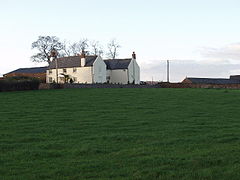Borras
Borras
|
|
|---|---|
 Borras Hall |
|
| Borras shown within Wrexham | |
| OS grid reference | SJ347522 |
| Community | |
| Principal area | |
| Country | Wales |
| Sovereign state | United Kingdom |
| Post town | WREXHAM |
| Postcode district | LL13 |
| Dialling code | 01978 |
| Police | North Wales |
| Fire | North Wales |
| Ambulance | Welsh |
| EU Parliament | Wales |
| UK Parliament | |
| Welsh Assembly | |
Borras (Welsh: Bwras) is an area to the north-east of Wrexham, Wales. It is part of the community of Holt.
The nearby residential area of Borras Park is named after Borras but is part of the community of Acton, Wrexham.
Although no human occupation sites have been found, the area of Borras has revealed some of the earliest traces of habitation in the area. A number of Mesolithic flint tools have been found adjacent to Borras Farm. A Neolithic Axe head was also found near Bryn-Gryfydd and a hoard of Bronze Age metalwork.
During the Middle Ages, according to the Wrexham historian Alfred N. Palmer, Borras (then called Borrasham) formed two townships of the mesne manor of Isycoed, itself one of the manors of the marcher lordship of Bromfield; the townships were known as Borrasham Hwfa and Borrasham Riffri. It is known that an extensive farmed rabbit warren was in existence in the area at the time. Palmer noted that the name Borrasham was also written Burras or Borras (possibly from the Old English beorgas, "burial-mounds"), and that the latter forms came to be used for the township in order to avoid confusion with Bersham.
Borras Hall is an early 17th-century former manor house. It is believed that it replaced an early 13th-century house on the same site. In 1988 Madoc's lead seal was discovered at Burras Hall that dated to the 13th century and is believed to be the seal of the lords of Borras and Erlas who built Plas ym Mwras in about 1200. The seal was sent to Cardiff for verification and has never been seen since, on inquiring as to the whereabouts of the seal Cardiff stated that they only have a copy of the seal. The Hall was owned by the Brereton Family until 1789, when it was sold to a Mr Twigg for £40,000.00 and then later sold to Baron Kenyon for £24,000.00.
...
Wikipedia

